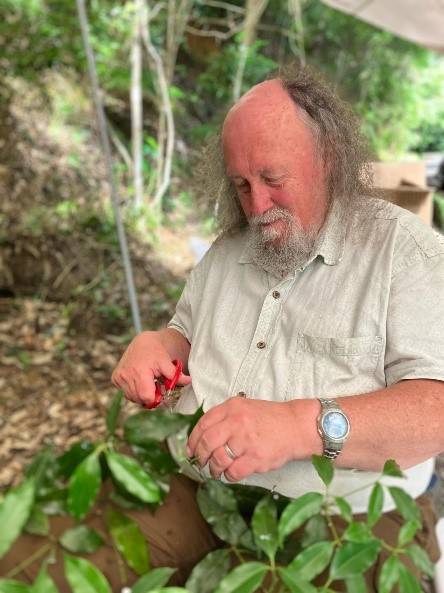Introduction
Nature has always fascinated us with its diversity, and one of the most diverse ecosystems on our planet can be found in tropical rainforests. These lush green wonders are home to an astounding variety of plant species, each uniquely adapted to thrive in this complex environment. Solving the mysteries of tropical plant traits is a critical activity for understanding the delicate balance of these ecosystems and their response to environmental changes. Recently, members from the LEMONTREE team embarked on a challenging yet rewarding journey to China, to undertake a Tropical Plant Trait Survey, shedding light on the traits of 136 woody species from three diverse forest sites.
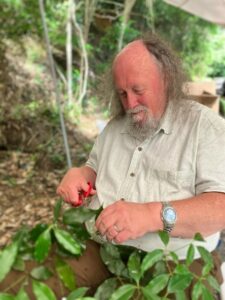
In June, the team led by LPICEA with Prof Sandy Harrison and Prof Colin Prentice, embarked on their journey to Hainan, China’s southernmost province, known for its breathtaking landscapes and rich biodiversity. Hainan provided an ideal setting for their research, offering two rainforest sites and one dry tropical forest site, each housing a treasure trove of plant species. The team geared up for two weeks of intensive fieldwork, where they aimed to gather critical morphometric, leaf economic, photosynthetic, and hydraulic trait data from the collected samples.
In the midst of nature’s challenges
Despite their mission’s excitement, the team knew that working in tropical rainforests would present its own challenges. Enduring the heat, humidity and torrential downpours, they persevered, determined to unveil the secrets hidden within the foliage. Armed with research tools and equipment, they ventured deep into the forests, where every step brought them closer to discovering the traits that made each species unique.
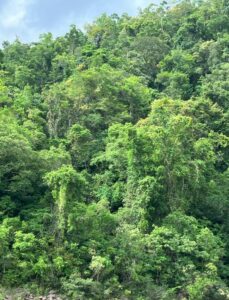
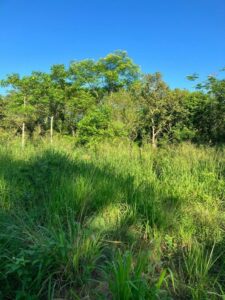
Left: Site 1: One of the two tropical rainforests sampled. Right: Site 3- a dry tropical forest in Hainan.
From data collection to detailed analysis

The team’s diligent efforts involved carefully sampling 136 woody species across the three sites. These samples were destined for meticulous leaf chemistry analysis and isotope measurements. However, before packing the samples, an essential step awaited them – the careful cleaning of leaves. In the dense tropical forest sites, many leaves were adorned with algae, fungus, or dirt. Each leaf had to be painstakingly cleaned to ensure accurate chemical analysis and avoid contamination before preservation.
This video by LPICEA captures the fieldwork perfectly (even if it does make it look easier than it was!): https://mp.weixin.qq.com/s/Sm_0YUUjPpPofz_SWJBd2Q
Sandy Harrison’s reflections
Sandy Harrison (LEMONTREE PI from the University of Reading), applauded the team’s dedication, acknowledging the challenges they faced during the data collection. She expressed excitement over the new approach they adopted – sampling all tree species to study within-site trait variability. This innovative method would undoubtedly enrich their research findings, offering new insights into the intricate web of tropical plant traits.
Looking forward
With the fieldwork completed and samples safely collected, the LEMONTREE team returned to their labs, eagerly awaiting the results of their hard work. The data they gathered promises to unlock a deeper understanding of the adaptations that allow these plant species to flourish in their unique habitats. We look forward to sharing our results soon.
The Team
Led by the Lab of Plant Interactions: Climate, Ecosystem, and Atmosphere (LPICEA) at Tsinghua University, the team consisted of 14 passionate researchers from 7 renowned institutions. Their distinguished visiting professors, Colin Prentice from Imperial College London and Sandy Harrison from the University of Reading, spearheaded this ambitious fieldwork. Complementing the team were researchers from Nanjing Forestry University, Hainan University, the University of Hong Kong, and Beijing Forestry University.
Thanks to the fieldwork team:
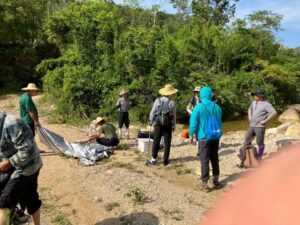 Wang Han, Jian Zhou, Huiying Xu, Han Zhang, Zeyu Feng, Yali Ding, Shanshan Song, Shengbin Ye (Tshinghua University); Iain Colin Prentice (Imperial College London); Sandy Harrison (University of Reading); Meng Li (Nanjing Forestry University); Shengchao Qiao, Bozhou Cao, Aohua Yang (Hainan University); Runxi Wang (University of Hong Kong) and Caixia Jiang (Beijing Forestry University)
Wang Han, Jian Zhou, Huiying Xu, Han Zhang, Zeyu Feng, Yali Ding, Shanshan Song, Shengbin Ye (Tshinghua University); Iain Colin Prentice (Imperial College London); Sandy Harrison (University of Reading); Meng Li (Nanjing Forestry University); Shengchao Qiao, Bozhou Cao, Aohua Yang (Hainan University); Runxi Wang (University of Hong Kong) and Caixia Jiang (Beijing Forestry University)

